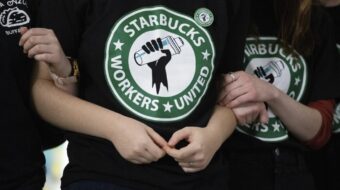
WASHINGTON—The U.S. jobless rate unexpectedly declined 1.2 percentage points in May, to 13.3%, according to low-ball figures issued by the Bureau of Labor Statistics on June 5.
An outpouring of officials and commentators promptly declared that the figure is artificially low and even BLS itself, in a technical note, said the rate doesn’t include another three percent of workers who lost their jobs due to the coronavirus pandemic. They’re classified as on “temporary layoff.”
BLS’s own weekly survey, released the day before and more up to date, noted some 42 million people filed for jobless benefits since the mass closures and firings due to the coronavirus pandemic began in mid-March. Add to that the 7.14 million jobless in March, before the pandemic really hit, and you arrive at 50 million or more unemployed. What that means is that at as much as one third of the ready-to-work workforce is unemployed, or 33 percent rather than the 13.5 percent touted in a speech today by Trump.
And the BLS survey of metro areas, released June 3, showed every single one of the nation’s 389 metro areas lost jobs and saw higher unemployment rates due to the pandemic. Some of the figures were staggering, led by a 35% jobless rate in a smaller Hawaii metro area – not Honolulu – compared to 2.5% exactly a year before.
Those real job loss numbers didn’t stop right-wing GOP President Donald Trump from bragging today that the economy is on its way back. They also didn’t stop capitalists who cheer huge numbers of jobless from pushing the stock market up by hundreds of points.
The official claim by the BLS is that the number of unemployed fell by 2.09 million in May, as of the week of May 12, when BLS finished its survey. That still left 21 million unemployed according to the undercounted BLS figures. The labor department figures do not count dropouts from the labor force or people forced to toil part-time when they really want full-time jobs – or once had them.
“If all the 32.5 million workers who are out of work as a result of the virus had shown up as unemployed, the unemployment rate would have been 19.7% in May instead of 13.3%,” Economic Policy Institute Policy Director Heidi Shierholz tweeted.
“Here is why we are not out of the woods because of the May report from @BLS.gov: The increase in median length of unemployment, the big increase…means slow slogging, and growing threats that “temporary” layoffs become permanent,” tweeted AFL-CIO Policy Director and chief economist Bill Spriggs.
In April, as he pointed out, the median jobless worker was out for two weeks, meaning half of all the unemployed were out less than that and the other half more. In May, the median was almost two months (7.7 weeks).
In a further indication of basic U.S. income inequality – a key point in recent nationwide protests against systemic racism — Shierholz noted the official jobless rate for African-Americans actually rose by 0.1% in May, to 16.8%. The white rate accounted for all of the overall decline.
BLS bases its figures on separate surveys of individuals and businesses. It said one reason for the
decline in monthly jobless rates was the start of reopening of businesses, state by state, and that another was federal payments – supposedly to small businesses – to keep workers on their payrolls. Those, of course, are not permanent.
But BLS did not respond to questions about whether its survey is weighted by states. Several big “red states,” notably Texas, Florida and Georgia, reopened before the rest. Those governors follow the lead of Trump.
Trump, and the governors, refuse to acknowledge the pandemic and continue to downplay the continued spread of the disease. The coronavirus has sickened 1.874 million people as of 9:30 a.m. on June 5 and killed 108,238.
In a separate survey, businesses claimed to create 3.09 million jobs in May, a small fraction of the 21.08 million jobs they claimed to cut the prior two months due to closures needed to combat the community spread of the coronavirus pandemic.
But most of those “returning” jobs were low-paying, part-time, or both. BLS said average hourly wages dropped by 14 cents in May. And 1.371 million of the re-created jobs were in bars and restaurants – which still left that sector with 4.08 million lost jobs since March, the last month before the pandemic virtually shut the industry down.
In addition, BLS reported average hourly earnings in May in “leisure and hospitality,” which includes the bars, restaurants and hotels, fell by 20 cents, to $14.43. It was dead last among all categories, by far, as usual.
Factories claimed to add 227,000 jobs in May, to 11.71 million. Cars led the way, adding 27,700 to 662,000 as the Detroit 3 reopened after coronavirus-caused shutdowns. The catch to that improvement is that car plants, including Detroit and foreign transplants had employed 993,600 workers in March, before the shutdowns. And there were still 1.78 million jobless factory workers (11.6%) in May, five times as many as in May, 2019.
Construction showed a similar pattern: Job gains in May (+464,000 jobs, to 7.043 million) but thousands of more jobless construction workers last month – 1.19 million and one of every eight – than in May 2019, when 294,000 (3.2%) were jobless.
While the private sector claimed to create jobs, governments lost them, especially state and local schools. Schools were shut down from coast to coast to help stop community spread of the coronavirus. They lost 613,000 jobs in April and another 373,200 jobs in May.
Overall, state and local governments had to shed 1.54 million workers in those two months, even as demand for their services — especially jobless aid – skyrocketed while their income cratered. They’re seeking $1 trillion in federal aid so they don’t have to lay off more teachers and workers.












Comments